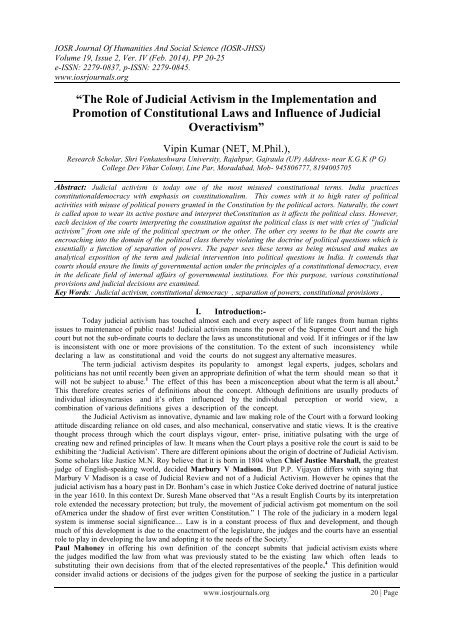Judicial ReEngineering
Judicial ReEngineering
Judicial ReEngineering
You also want an ePaper? Increase the reach of your titles
YUMPU automatically turns print PDFs into web optimized ePapers that Google loves.
IOSR Journal Of Humanities And Social Science (IOSR-JHSS)<br />
Volume 19, Issue 2, Ver. IV (Feb. 2014), PP 20-25<br />
e-ISSN: 2279-0837, p-ISSN: 2279-0845.<br />
www.iosrjournals.org<br />
“The Role of <strong>Judicial</strong> Activism in the Implementation and<br />
Promotion of Constitutional Laws and Influence of <strong>Judicial</strong><br />
Overactivism”<br />
Vipin Kumar (NET, M.Phil.),<br />
Research Scholar, Shri Venkateshwara University, Rajabpur, Gajraula (UP) Address- near K.G.K (P G)<br />
College Dev Vihar Colony, Line Par, Moradabad, Mob- 945806777, 8194005705<br />
Abstract: <strong>Judicial</strong> activism is today one of the most misused constitutional terms. India practices<br />
constitutionaldemocracy with emphasis on constitutionalism. This comes with it to high rates of political<br />
activities with misuse of political powers granted in the Constitution by the political actors. Naturally, the court<br />
is called upon to wear its active posture and interpret theConstitution as it affects the political class. However,<br />
each decision of the courts interpreting the constitution against the political class is met with cries of “judicial<br />
activism” from one side of the political spectrum or the other. The other cry seems to be that the courts are<br />
encroaching into the domain of the political class thereby violating the doctrine of political questions which is<br />
essentially a function of separation of powers. The paper sees these terms as being misused and makes an<br />
analytical exposition of the term and judicial intervention into political questions in India. It contends that<br />
courts should ensure the limits of governmental action under the principles of a constitutional democracy, even<br />
in the delicate field of internal affairs of governmental institutions. For this purpose, various constitutional<br />
provisions and judicial decisions are examined.<br />
Key Words: <strong>Judicial</strong> activism, constitutional democracy , separation of powers, constitutional provisions ,<br />
I. Introduction:-<br />
Today judicial activism has touched almost each and every aspect of life ranges from human rights<br />
issues to maintenance of public roads! <strong>Judicial</strong> activism means the power of the Supreme Court and the high<br />
court but not the sub-ordinate courts to declare the laws as unconstitutional and void. If it infringes or if the law<br />
is inconsistent with one or more provisions of the constitution. To the extent of such inconsistency while<br />
declaring a law as constitutional and void the courts do not suggest any alternative measures.<br />
The term judicial activism despites its popularity to amongst legal experts, judges, scholars and<br />
politicians has not until recently been given an appropriate definition of what the term should mean so that it<br />
will not be subject to abuse. 1 The effect of this has been a misconception about what the term is all about. 2<br />
This therefore creates series of definitions about the concept. Although definitions are usually products of<br />
individual idiosyncrasies and it‟s often influenced by the individual perception or world view, a<br />
combination of various definitions gives a description of the concept.<br />
the <strong>Judicial</strong> Activism as innovative, dynamic and law making role of the Court with a forward looking<br />
attitude discarding reliance on old cases, and also mechanical, conservative and static views. It is the creative<br />
thought process through which the court displays vigour, enter- prise, initiative pulsating with the urge of<br />
creating new and refined principles of law. It means when the Court plays a positive role the court is said to be<br />
exhibiting the „<strong>Judicial</strong> Activism‟. There are different opinions about the origin of doctrine of <strong>Judicial</strong> Activism.<br />
Some scholars like Justice M.N. Roy believe that it is born in 1804 when Chief Justice Marshall, the greatest<br />
judge of English-speaking world, decided Marbury V Madison. But P.P. Vijayan differs with saying that<br />
Marbury V Madison is a case of <strong>Judicial</strong> Review and not of a <strong>Judicial</strong> Activism. However he opines that the<br />
judicial activism has a hoary past in Dr. Bonham‟s case in which Justice Coke derived doctrine of natural justice<br />
in the year 1610. In this context Dr. Suresh Mane observed that “As a result English Courts by its interpretation<br />
role extended the necessary protection; but truly, the movement of judicial activism got momentum on the soil<br />
ofAmerica under the shadow of first ever written Constitution.” 1 The role of the judiciary in a modern legal<br />
system is immense social significance.... Law is in a constant process of flux and development, and though<br />
much of this development is due to the enactment of the legislature, the judges and the courts have an essential<br />
role to play in developing the law and adopting it to the needs of the Society. 3<br />
Paul Mahoney in offering his own definition of the concept submits that judicial activism exists where<br />
the judges modified the law from what was previously stated to be the existing law which often leads to<br />
substituting their own decisions from that of the elected representatives of the people. 4 This definition would<br />
consider invalid actions or decisions of the judges given for the purpose of seeking the justice in a particular<br />
www.iosrjournals.org<br />
20 | Page

















